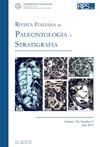应用显微ct成像技术研究比利时早始新世(伊普勒世)历史和新采集的belosaepia (sepiida, colo总科,cephalopoda)标本
IF 1.9
3区 地球科学
Q2 GEOLOGY
引用次数: 0
摘要
高分辨率X射线计算机断层扫描技术的应用使人们能够评估比利时伊普雷阶(始新世早期)历史上和新收集的贝洛萨目(贝洛萨总科、Coleoidea、头足目)标本,并为茎群海泡石的分类学提供分辨率。新发现来自埃格姆Ampe粘土岩中埃格姆卡佩尔粘土段(Tielt组)的基底层,以及马尔克Koekelberg粘土岩中Roubaix粘土段(Kortrijk组)的中部(比利时西兰德省)。结合历史和新收集的材料,我们可以得出结论,只有一个物种可以被肯定地识别,即三卡氏贝洛萨埃皮虫(Watelet,1851),并且目前所有记录的发生都仅限于伊普雷阶中期(NP11-NP12)。这似乎与巴黎、伦敦和汉普郡盆地中的三卡氏贝洛萨埃皮虫的出现非常吻合。显微CT成像是研究钙化遗骸的一种优秀的非破坏性工具。在Belosaepia骨骼中,这种方法使我们能够识别生长线、个体发生变化和吸收。该技术与生物地层学评估结合使用,有可能成为分类学分配和修订的主要辅助手段。在目前的研究中,它还强调了保留在标本残留沉积物中的重要地层化石(如Nummulites)。这提供了额外的地层信息,否则这些信息可能会丢失,或者不会记录在较旧的样本中。本文章由计算机程序翻译,如有差异,请以英文原文为准。
APPLYING MICRO-CT IMAGING IN THE STUDY OF HISTORICALLY AND NEWLY COLLECTED SPECIMENS OF BELOSAEPIA (SEPIIDA, COLEOIDEA, CEPHALOPODA) FROM THE EARLY EOCENE (YPRESIAN) OF BELGIUM
The application of high-resolution X-ray computed tomography permits an appraisal of historically and newly collected specimens of Belosaepia (Belosaepiidae, Coleoidea, Cephalopoda) from the Ypresian (Early Eocene) of Belgium and provides resolution into the taxonomy of stem-group sepiids. The new finds are from the basal beds of the Egemkapel Clay Member (Tielt Formation) in the Ampe claypit at Egem and in the middle of the Roubaix Clay Member (Kortrijk Formation) in the Koekelberg claypit at Marke (province of West-Flanders, Belgium). Combining the historically and newly collected material allows us to conclude that only a single species can be positively identified, namely Belosaepia tricarinata (Watelet, 1851), and that all currently documented occurrences are restricted to the middle Ypresian (NP11-NP12). This seems to correspond well with the occurrence of Belosaepia tricarinata in the Paris, London, and Hampshire basins. Micro-CT imaging is an excellent, non-destructive tool in the study of the calcified remains. In the Belosaepia skeleton, this method allowed us to identify growth lines, ontogenetic changes, and resorption. Utilised in conjunction with a biostratigraphic assessment, this technology has the potential to be a major aid in taxonomic assignments and revisions. In the current study, it also highlighted stratigraphically important fossils (e.g. Nummulites) retained in the residual sediment attached to the specimens. This provides additional stratigraphic information that may otherwise be lost, or not recorded in older samples.
求助全文
通过发布文献求助,成功后即可免费获取论文全文。
去求助
来源期刊
CiteScore
3.60
自引率
4.30%
发文量
28
审稿时长
>12 weeks
期刊介绍:
The Rivista Italiana di Paleontologia e Stratigrafia was founded in 1895. It publishes original papers dealing with all fields of paleontology and of stratigraphy, from Italy and the Mediterranean to the Tethys, as well across the globe from China to North America.

 求助内容:
求助内容: 应助结果提醒方式:
应助结果提醒方式:


